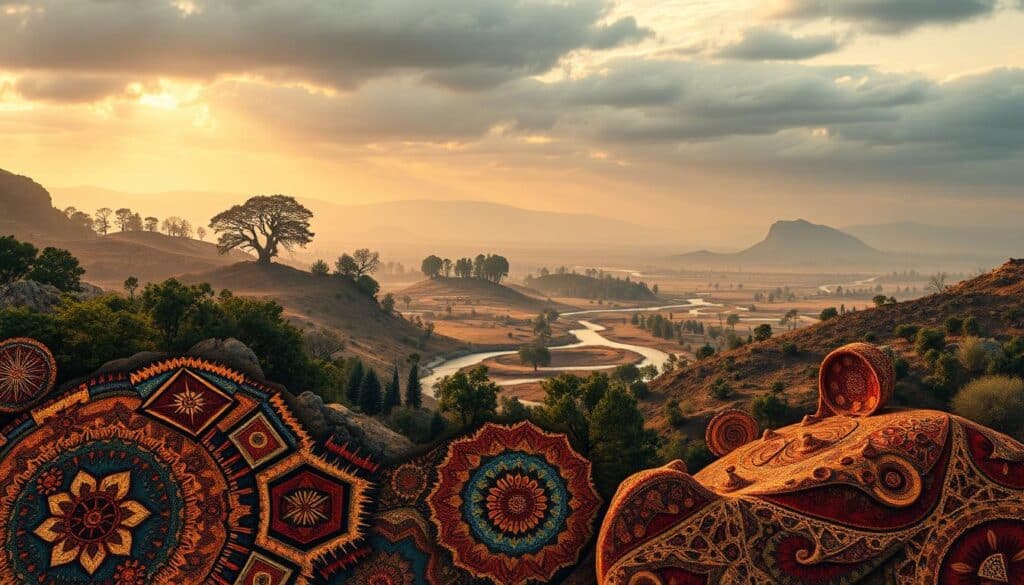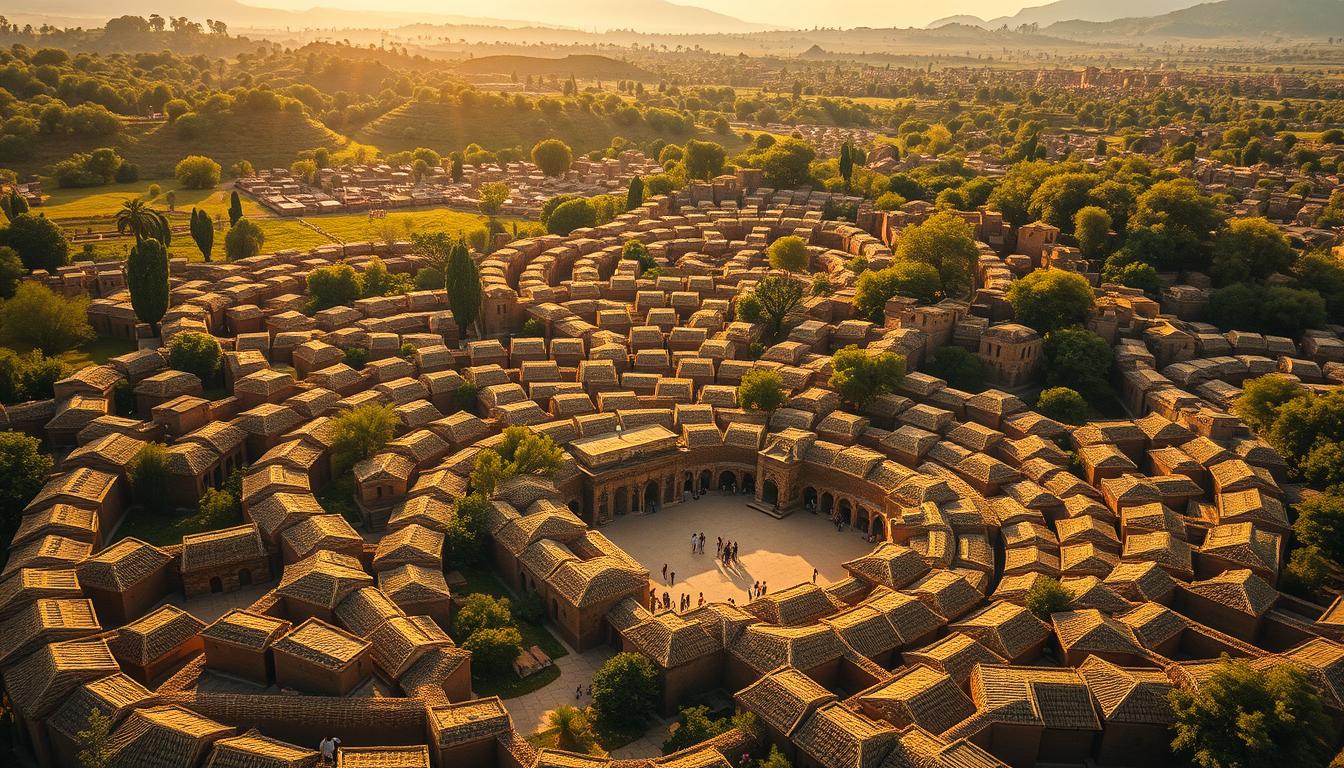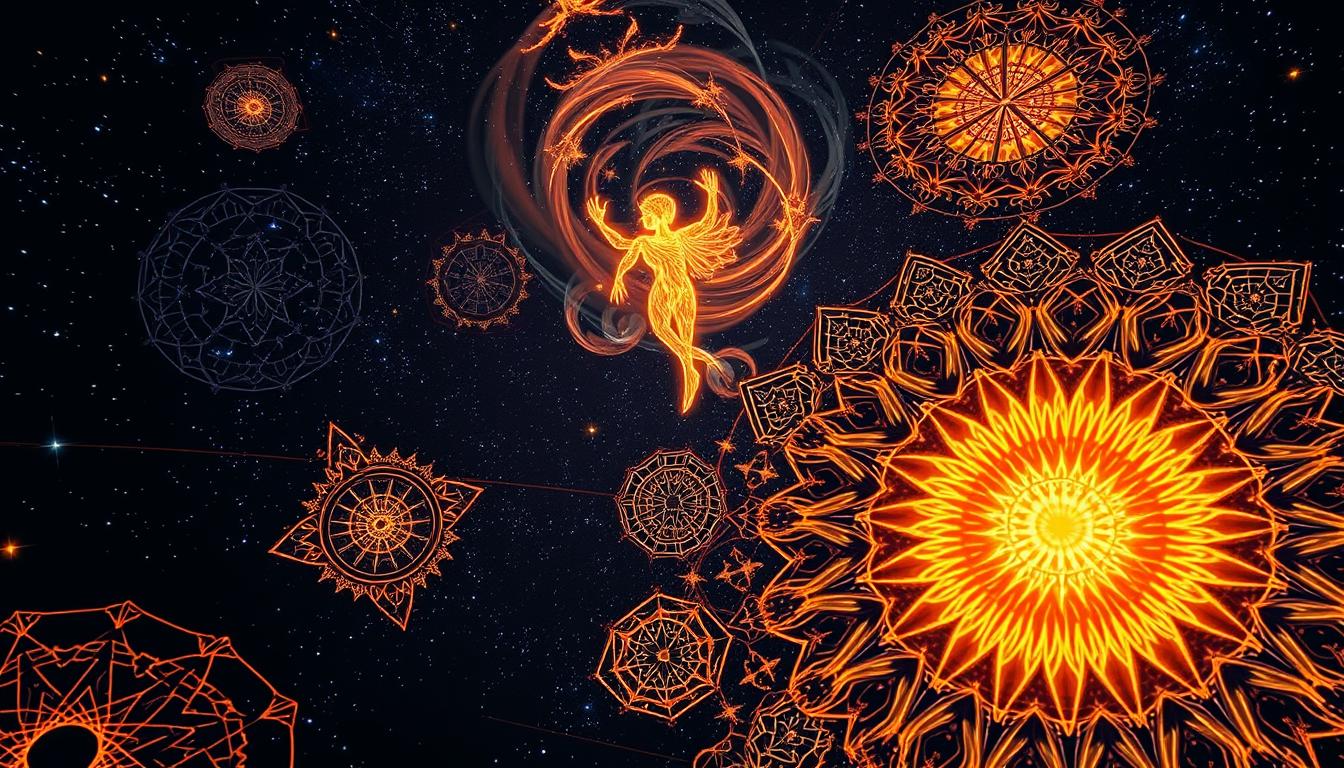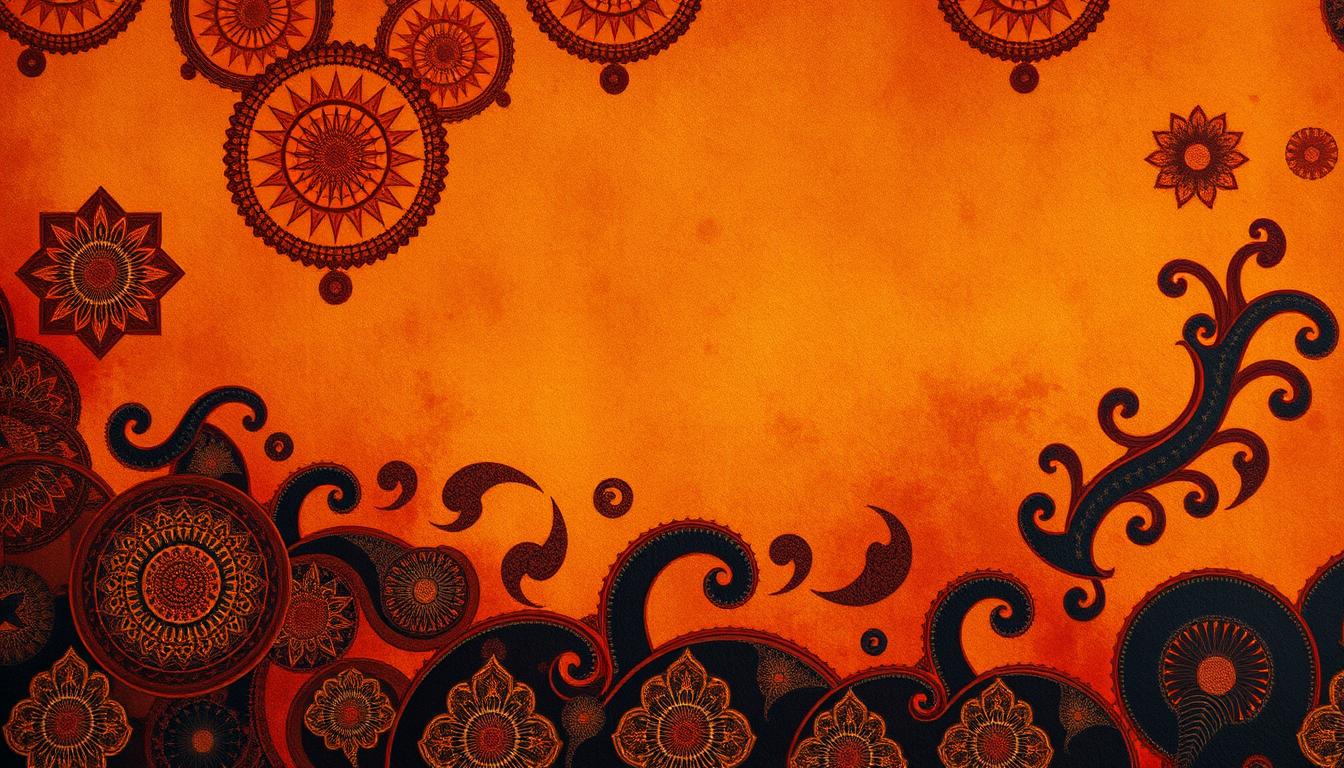Fractal symbolism helps keep indigenous knowledge alive. These patterns are everywhere in nature. They link to diverse cultural practices of indigenous groups.
These designs are more than pretty. They carry the wisdom and traditions of many generations. Studying them shows how math affects art, beliefs, and community life.
Introduction to Fractal Symbolism
Fractal symbolism is a cool mix of math, art, and culture. It shows how patterns that repeat themselves are part of nature and how we express ourselves. This overview highlights the basic ideas behind fractal symbolism. It shows its importance in different areas.
In indigenous cultures, fractal patterns are a key cultural symbol. They showcase identity and the flow of life. You can see these complex patterns in art, clothes, and buildings. They link life and the universe together. These symbols are key to keeping cultural stories alive. They make indigenous art beautiful and full of meaning.
Fractal symbolism is more than just pictures. It carries stories and deep thoughts that have been shared for many generations. Getting to know these symbols helps us understand how indigenous people see the world and their history.

The Concept of Fractals in Nature
Fractals show the amazing order in nature. You can see these patterns in trees, rivers, and coastlines. They combine complexity with mathematical rules.
Looking at tree branches or river paths, we see nature’s patterns. This shows our deep connection to the environment.
The study of fractals reveals how elements in nature work together in balance. This understanding has been valued by many native cultures. It teaches us to care for our planet. Fractals represent both the unpredictable and the beautiful in nature. They show nature’s ability to endure and evolve.
Preserving Indigenous Knowledge Through Fractal Symbolism
Fractal symbolism plays a key role in protecting indigenous knowledge. It shows the cultural essence of communities through repeating motifs and designs. These patterns carry the values and wisdom of cultures. They help keep stories and traditions alive through generations.
The Role of Fractals in Indigenous Cultures
For indigenous cultures, fractals are a way to share core ideas and beliefs. They appear in many areas, showing unity and how everything is connected. Fractal patterns highlight the bond communities have with nature and their ancestors. They help explain complex links between nature and human societies.
Examples of Fractal Patterns in Cultural Practices
Many cultural practices include fractal patterns. In rituals, one might see detailed designs in masks or textiles which reflect tribal beliefs. Fractal symbolism is also found in storytelling. Oral histories use these patterns to describe the cycles of life and growth. This artistic use of fractals keeps traditions alive and teaches important lessons.
Fractal Geometry in African Culture
Fractal geometry is key in African culture. It shapes designs and how spaces in villages are laid out. You’ll see it in how villages are built, with a common area in the middle. The houses are set up around it in circles. This way, the community is at the heart, fitting neatly into the natural landscape.
Settlement Patterns and Urban Planning
In many African communities, the way villages are set up shows a deep understanding of fractal geometry. They are designed for people to easily gather together, but also have their own private spaces. These designs feature:
- Central meeting spaces designed for social gatherings.
- Housing arranged in symmetrical patterns radiating from central points.
- Efficient use of local materials, reflecting environmental adaptation.
Architecture and Building Design
Traditional African houses showcase fractal geometry through repeated geometric shapes. These designs are practical but also carry cultural and spiritual meanings. Key features include:
- Use of patterns that signify wealth, heritage, or function.
- Integration of natural elements into the architectural framework.
- Structures that harmonize with the environment, showcasing sustainability.
Spiritual and Cosmological Beliefs Reflected in Fractals
In many indigenous cultures, fractal symbols are very important. They show a strong connection between the universe and individuals in African communities. This shows that big cosmic patterns can be seen in the everyday lives of people.
Sacred places often use fractal designs. These patterns symbolize life’s cycles and the balance between humans and the universe. They represent existence as an endless loop, highlighting our shared journey through time.
Fractal symbols help many tribes express their spirituality. They blur the lines between the seeable world and the spiritual one. This blend of art and faith creates a deep sense of unity and purpose. It underlines the importance of communal ceremonies and shared beliefs about the universe.
Impact of Fractal Symbolism on Art and Design
Fractal symbolism has greatly changed art and design, especially in textiles. The patterns and shapes from nature inspire many textile works. These designs grab our attention and carry deep meanings about culture and identity.
Textile Designs and Patterns
Textiles show the big impact of fractal influence vividly. In traditional African fabrics, complex patterns showcase the balance of nature and culture. These designs express ideas of fertility, unity, and the world around us.
Artists and designers use the science of fractals to make eye-catching works. These pieces connect with people deeply, both in how they look and what they feel.
- Symbolism in Patterns: Many textiles incorporate symbols representing life events and natural phenomena.
- Geometric Designs: Repeated shapes form complex compositions, lending a sense of order and beauty.
- Cultural Significance: Each pattern tells a unique story, reflecting the rich tapestry of cultural identity.
Social Organization and Governance in Indigenous Communities
Fractal structures have a big impact on indigenous communities’ leadership and social setup. These structures are like patterns that repeat, small group activities mirror the community’s actions. This setup ensures everyone’s voice can be heard in important decisions.
Governance here isn’t just a top-down affair. Everyone gets to play a part. This method builds a strong sense of duty and makes sure community actions reflect what the people want. It shows that fractal patterns help keep unity but still allow for different views.
- Empowerment of community members at all governance levels
- Representation of local needs within broader decision-making frameworks
- Promotion of communal values through participatory governance
The fractal way of managing things underlines the value of cultural identity. It strengthens bonds and shared duties among members of the community.
Education and Knowledge Transmission Through Fractals
Fractal patterns are crucial in teaching within indigenous cultures. These patterns are part of traditional education, showing learning is holistic, not just straight lines. It involves storytelling, ceremonies, and hands-on learning. This method connects new learning to cultural heritage.
The repetitive nature of fractals helps in understanding and remembering cultural values. As people learn, they build on what they’ve learned before. This makes a solid base for passing on knowledge. Everyone in the community gets involved, creating a sense of togetherness and involvement.
Using fractal designs in education shows how all knowledge is connected. Students see how deep their traditions are while helping them grow. This approach doesn’t just increase personal knowledge; it also strengthens the community. It ensures the wisdom of the past stays alive.
Modern Applications of Fractal Symbolism
Fractal symbolism is now a big part of modern art, design, and architecture. Many artists and designers use fractal patterns that come from old traditions. This helps keep cultures alive while bringing new ideas to life.
In art, fractal symbolism lets artists explore complex ideas. They use fractal patterns to make beautiful murals, paintings, and sculptures. These works connect people to their history in an eye-catching way. They help modern viewers understand and appreciate their heritage.
Architects use fractal symbolism to create eco-friendly buildings. They blend fractal ideas into their work to make buildings that are good for the planet. This makes buildings use less energy and reduces waste. Plus, buildings designed this way often look like they belong to the local culture and landscape.
Fractal symbolism isn’t just about looking good. It shows how important traditional stories are, even in today’s world. By using fractals, artists and architects bring old wisdom to new projects. This invites everyone to look deeper into the designs and find their hidden meanings.
Significance of Fractal Symbolism in Contemporary Society
Fractal symbolism plays a big role in today’s world. It helps us understand cultural diversity and push for environmental care. This idea is both math-based and artistic. It shows how complex nature is and links old wisdom with new ways.
It encourages us to value our cultural roots and be more eco-friendly. It’s used in many areas, such as:
- Urban planning, integrating indigenous design principles that echo the interconnectedness found in nature.
- Education, where fractal patterns can enhance learning and retention by linking complex ideas through visual representation.
- Community development, encouraging collaboration and cohesion among diverse cultural groups.
Using fractal symbolism helps create broad plans that respect traditions and tackle today’s problems. It opens doors to new, forward-thinking solutions that honor our past and look to the future.
Conclusion
As we finish our journey into fractal symbolism, we see its power in connecting to cultural roots. These complex designs are more than just art or nature. They link us to cultural identities. Through nature, spirituality, and how communities are built, fractals show a deep understanding of life found in many indigenous cultures.
Fractals are seen in African buildings and traditional arts, highlighting the wisdom of these cultures. Understanding and valuing fractal symbolism means recognizing the importance of indigenous knowledge. This knowledge is often overlooked today.
Looking ahead, learning from fractal symbolism helps us celebrate diverse cultures and bring their insights into wider conversations. Indigenous knowledge is vital. Fractal designs help us connect deeply with our shared human story.



